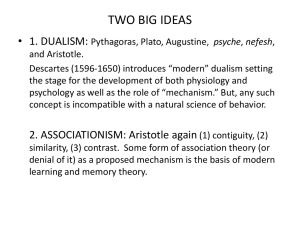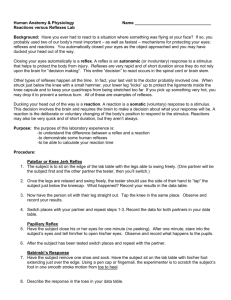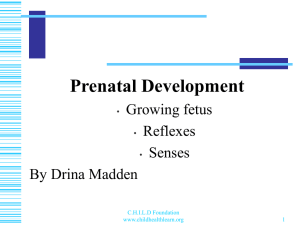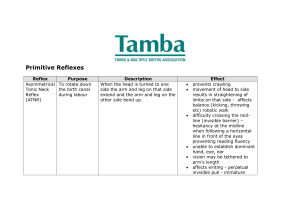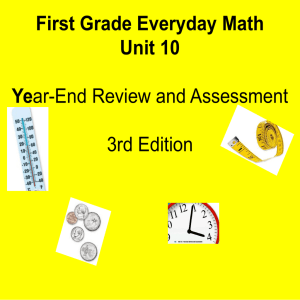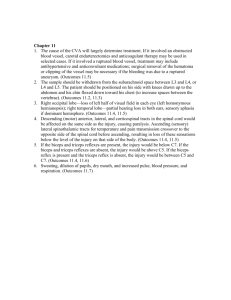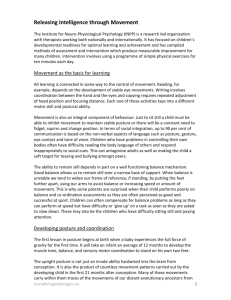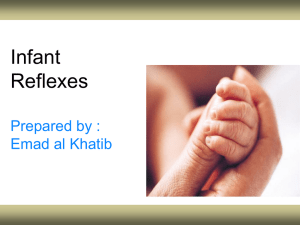Chlorophyll Chromatography
advertisement
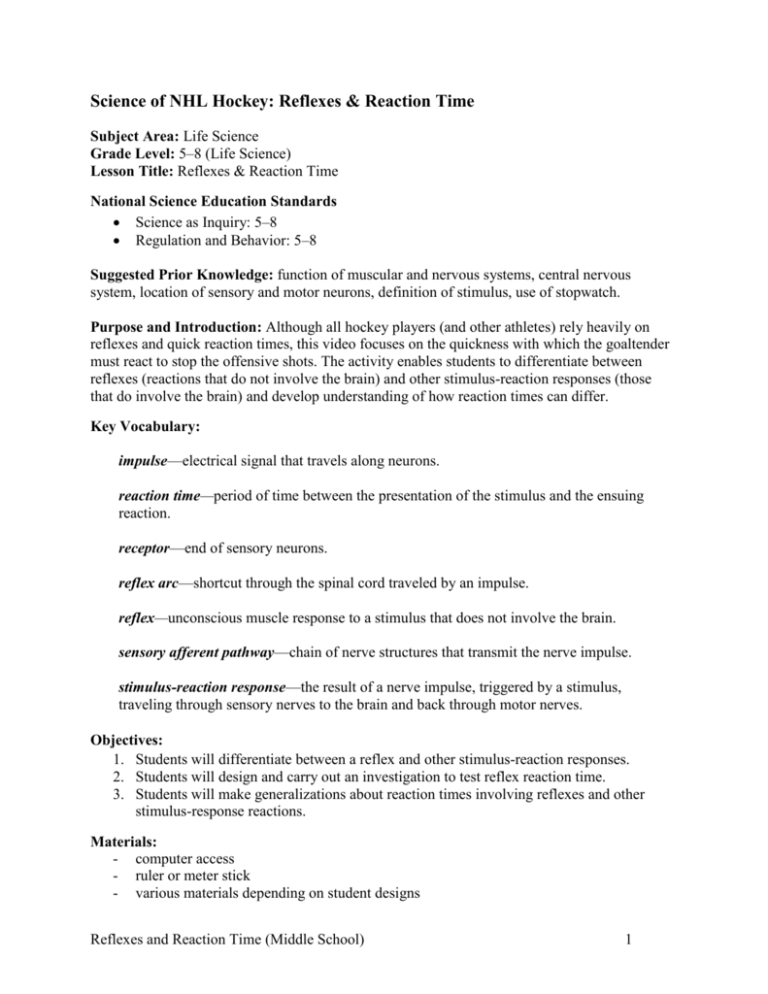
Science of NHL Hockey: Reflexes & Reaction Time Subject Area: Life Science Grade Level: 5–8 (Life Science) Lesson Title: Reflexes & Reaction Time National Science Education Standards Science as Inquiry: 5–8 Regulation and Behavior: 5–8 Suggested Prior Knowledge: function of muscular and nervous systems, central nervous system, location of sensory and motor neurons, definition of stimulus, use of stopwatch. Purpose and Introduction: Although all hockey players (and other athletes) rely heavily on reflexes and quick reaction times, this video focuses on the quickness with which the goaltender must react to stop the offensive shots. The activity enables students to differentiate between reflexes (reactions that do not involve the brain) and other stimulus-reaction responses (those that do involve the brain) and develop understanding of how reaction times can differ. Key Vocabulary: impulse—electrical signal that travels along neurons. reaction time—period of time between the presentation of the stimulus and the ensuing reaction. receptor—end of sensory neurons. reflex arc—shortcut through the spinal cord traveled by an impulse. reflex—unconscious muscle response to a stimulus that does not involve the brain. sensory afferent pathway—chain of nerve structures that transmit the nerve impulse. stimulus-reaction response—the result of a nerve impulse, triggered by a stimulus, traveling through sensory nerves to the brain and back through motor nerves. Objectives: 1. Students will differentiate between a reflex and other stimulus-reaction responses. 2. Students will design and carry out an investigation to test reflex reaction time. 3. Students will make generalizations about reaction times involving reflexes and other stimulus-response reactions. Materials: - computer access - ruler or meter stick - various materials depending on student designs Reflexes and Reaction Time (Middle School) 1 Procedure: 1. Before or after students view the video, have them brainstorm a list of actions that are reflexes or that require quick reaction times. Elicit from volunteers the sensory afferent pathway that an impulse follows in each action. Help students differentiate between true reflexes and other stimulus-response actions by identifying which are more likely protective actions that could occur in many situations and which might be practiced or associated with a particular sport or activity. Share with students primitive reflexes observed in infants, such as the sucking, Moro, and grasping reflexes that enable the survival of infants. (See Additional Resources below.) 2. Discuss with students how reaction time differs between a true reflex and a reaction that requires, at least initially, some level of conscious thought. Questions such as the following will help stimulate discussion: How do nerves cause muscles to effect actions? What is a reflex? How does it differ from other responses? Does everyone have the same reflexes? What are some examples? How does the need for an impulse to travel through the brain impact reaction time? Can reaction times be improved with practice? Can true reflex reaction times be improved with practice? Can you stop reflexes from occurring? Can you stop other kinds of reactions? 3. Lab protocols should be followed, incorporating safety equipment. Goggles must be worn at all times. 4. Ask students to think of ways to differentiate among the different kinds of actions they discussed earlier. Guide them to see how some actions happen automatically, without thinking or without practice. Divide students into small groups and challenge them to test for reflexes that remain after infancy, such as the blinking, patellar, startle, and pupil constriction reflexes. Students can research these reflexes and devise safe ways to test for each one. If needed, prompt student thinking with ideas such as the following: The tester and a respondent might stand on opposite sides of a strong window. The tester then throws cotton balls at the respondent’s face. A respondent might sit in a chair with his or her legs crossed, but looking away from the tester. A tester (of the same gender) could use the side of his or her hand to lightly tap just below the patella, or kneecap, of the respondent. A tester could engage a group of respondents in an activity, such as listening to music, reading, or watching a show. The tester then, at a random time, slams a book on a desk to make a loud noise. The respondents then record their reactions to the noise. And they could discuss how their responses can change based on what they are now expecting [similar to a goalie…] In a darkened room, a tester could use a stopwatch to time how quickly a respondent’s pupil constricts to maximum level once the bright, overhead lights have been switched on. 5. Encourage students to develop questions that emerge from a desire to better understand reflexes. They could determine how reaction time might be measured, such as timing and Reflexes and Reaction Time (Middle School) 2 degree of stimulus. For example, students might throw different sized balls, such as cotton balls, table-tennis balls, foam balls, and inflatable beach balls, or the loudness of the sound used to trigger the startle reflex could be varied. Encourage students to allow respondents to undergo several trials of the tests to determine the effects of practice and anticipation on reaction time. 6. Then instruct students to research ways to test reaction time for an action that requires, at least initially, some degree of intention. Many students may be familiar with the classic “ruler drop.” In this activity, one individual suspends a ruler or meter stick in the air, with the 0 mark at the bottom. A second individual holds his or her thumb and forefinger positioned slightly apart at the 0 mark. The first individual drops the ruler without warning, and the second individual grasps the ruler as quickly as possible between the thumb and forefinger. Some advantages of this method are the readily available equipment and that measurements on the ruler can be equated with time based on the following chart. Many reaction time tests also are available online for students to use. (See Additional Resources.) Instruct students to again allow respondents to undergo several trials to determine the effects of practice and anticipation on reaction time in these kinds of tests. Distance (centimeters) 5 10 15 20 25 30 Time (seconds) 0.10 0.14 0.17 0.20 0.23 0.25 7. Have students draw conclusions about whether those respondents with faster or more sensitive reflexes also have faster reaction times in other kinds of activities. Students might make comparisons of the observed reaction times with that of goalie Pekka Rinne. Remind students that the video explains that the quicker the reaction time, the more like a reflex the action is. Guide them to understand that quicker or more sensitive reflexes may or may not result in faster reaction times, but generally practice does. 8. As an extension, suggest the tests be administered under different distracting conditions, such as loud music, intermittent cheering from “fans,” while carrying on a conversation, while reading and responding to a text message, and so on. Encourage students to draw conclusions about how distractions such as these impact reaction time of reflexes and other kinds of stimulus-response actions and what they might do to mitigate those effects during certain activities. Additional Resources: http://www.exploratorium.edu/hockey/save1.html http://biology.clemson.edu/bpc/bp/Lab/110/reaction.htm Reflexes and Reaction Time (Middle School) 3 http://www.yalemedicalgroup.org/stw/Page.asp?PageID=STW001803 http://sciencenetlinks.com/lessons/reaction-time-1-how-fast-are-you/ http://articles.baltimoresun.com/1999-09-30/sports/9909300145_1_severna-parkgoalie-scoring-circle http://www.nlm.nih.gov/medlineplus/ency/article/003292.htm http://www.healthofchildren.com/N-O/Neonatal-Reflexes.html http://www.exploratorium.edu/baseball/reactiontime.html http://www.topendsports.com/testing/reactiontest.htm http://www.bbc.co.uk/science/humanbody/sleep/sheep/reaction_version5.swf Reflexes and Reaction Time (Middle School) 4 Student Worksheet for Reflexes & Reaction Time Experiment Title: _____________________________Date: __________Name: _____________ Student Question or Hypothesis: ____________________________________________________________________________ Materials: - computer access - ruler or meter stick - various materials depending on student designs Safety Concerns: _______________________________________________________________________ _______________________________________________________________________ _______________________________________________________________________ Procedure: ____________________________________________________________________ __________________________________________________________________________ __________________________________________________________________________ __________________________________________________________________________ __________________________________________________________________________ __________________________________________________________________________ __________________________________________________________________________ __________________________________________________________________________ __________________________________________________________________________ __________________________________________________________________________ Reflexes and Reaction Time (Middle School) 5 Data: Observations: __________________________________________________________________ ___________________________________________________________________________ ___________________________________________________________________________ ___________________________________________________________________________ Analysis of Data: _____________________________________________________________________________ _____________________________________________________________________________ _____________________________________________________________________________ _____________________________________________________________________________ _____________________________________________________________________________ _____________________________________________________________________________ Conclusion: ___________________________________________________________________ _____________________________________________________________________________ _____________________________________________________________________________ _____________________________________________________________________________ _____________________________________________________________________________ _____________________________________________________________________________ _____________________________________________________________________________ Reflexes and Reaction Time (Middle School) 6
